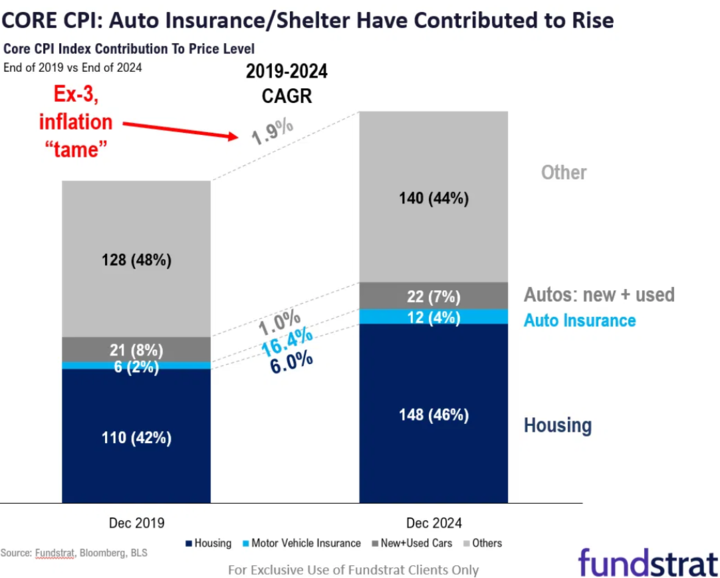A daily market update from FS Insight — what you need to know ahead of opening bell.
“You cannot dream yourself into a character; you must hammer and forge yourself one.” – James Anthony Froude
Overnight
Consumer prices rise more than expected in January BBG
US, UK refuse to sign AI safety declaration at international summit SEM
AP says it was blocked from Oval Office event AX
Trump advisers eye bank regulator consolidation after targeting CFPB WSJ
California’s insurer for people without private coverage needs $1 billion more for LA fires claims AP
Powell squashes the possibility that the Fed will develop its own digital currency CNBC
Travelers sees $1.7 billion pretax catastrophe losses from California wildfires WSJ
CVS shares pop 10% on big earnings beat, even as high medical costs drag down insurance unit CNBC
Steve Bannon pleads guilty in border wall fraud case WSJ
Crackdown on Bangladesh protesters may be crime against humanity, UN says BBC
Spacecraft probing cosmic evolution spies an ‘Einstein ring’ SCI
Chart of the Day

| Overnight | ||||||||||||||||||||||||||||||||||||||||||||||||||||
| ||||||||||||||||||||||||||||||||||||||||||||||||||||
| APAC | ||||||||||||||||||||||||||||||||||||||||||||||||||||
| ||||||||||||||||||||||||||||||||||||||||||||||||||||
| Europe | ||||||||||||||||||||||||||||||||||||||||||||||||||||
| ||||||||||||||||||||||||||||||||||||||||||||||||||||
| FX | ||||||||||||||||||||||||||||||||||||||||||||||||||||
| ||||||||||||||||||||||||||||||||||||||||||||||||||||
| Crypto | ||||||||||||||||||||||||||||||||||||||||||||||||||||
| ||||||||||||||||||||||||||||||||||||||||||||||||||||
| Commodities and Others | ||||||||||||||||||||||||||||||||||||||||||||||||||||
| ||||||||||||||||||||||||||||||||||||||||||||||||||||
| US Treasuries | ||||||||||||||||||||||||||||||||||||||||||||||||||||
| ||||||||||||||||||||||||||||||||||||||||||||||||||||
| UST Term Structure | ||||||||||||||||||||||||||||||||||||||||||||||||||||
| ||||||||||||||||||||||||||||||||||||||||||||||||||||
| Yesterday's Recap | ||||||||||||||||||||||||||||||||||||||||||||||||||||
| ||||||||||||||||||||||||||||||||||||||||||||||||||||
| USD HY OaS | ||||||||||||||||||||||||||||||||||||||||||||||||||||
|
| Date | Time | Description | Estimate | Last |
|---|---|---|---|---|
| 2/12 | 8:30AM | Jan CPI m/m | 0.3 | 0.4 |
| 2/12 | 8:30AM | Jan Core CPI m/m | 0.3 | 0.2 |
| 2/12 | 8:30AM | Jan CPI y/y | 2.9 | 2.9 |
| 2/12 | 8:30AM | Jan Core CPI y/y | 3.1 | 3.2 |
| 2/13 | 8:30AM | Jan PPI m/m | 0.3 | 0.2 |
| 2/13 | 8:30AM | Jan Core PPI m/m | 0.3 | 0.0 |
| 2/14 | 8:30AM | Jan Import Price m/m | 0.4 | 0.1 |
| 2/14 | 8:30AM | Jan Retail Sales m/m | -0.2 | 0.4 |
| 2/18 | 10AM | Feb Homebuilder Sentiment | 47.0 | 47.0 |
| 2/18 | 4PM | Dec Net TIC Flows | n/a | 159.888 |
| Date | Time | Description | Estimate | Last |
|---|---|---|---|---|
| 2/12 | 8:30AM | Jan CPI m/m | 0.3 | 0.4 |
| 2/12 | 8:30AM | Jan Core CPI m/m | 0.3 | 0.2 |
| 2/12 | 8:30AM | Jan CPI y/y | 2.9 | 2.9 |
| 2/12 | 8:30AM | Jan Core CPI y/y | 3.1 | 3.2 |
| 2/13 | 8:30AM | Jan PPI m/m | 0.3 | 0.2 |
| 2/13 | 8:30AM | Jan Core PPI m/m | 0.3 | 0.0 |
| 2/14 | 8:30AM | Jan Import Price m/m | 0.4 | 0.1 |
| 2/14 | 8:30AM | Jan Retail Sales m/m | -0.2 | 0.4 |
| 2/18 | 10AM | Feb Homebuilder Sentiment | 47.0 | 47.0 |
| 2/18 | 4PM | Dec Net TIC Flows | n/a | 159.888 |
MORNING INSIGHT
Good morning!
There have been many “tape bombs” so far in 2024 (DeepSeek R1 and tariff headlines) but the resulting selling has been shallow. To us, this indicates that investors have already substantially de-risked.
Click HERE for more.
TECHNICAL
- SPX and QQQ remain range-bound ahead of CPI and PPI this week.
- Industrials hasn’t been too adversely affected by tariff announcements.
- Aluminum has begun to show evidence of a possible breakout back to monthly highs.
Click HERE for more.
CRYPTO
Of late we have seen weak flows and a lack of bullish conviction from traders and investors. However, in our view, the coming days could bring a breakout from the recent tight trading range.
Click HERE for more.
First News
President Donald Trump welcomed Japanese Prime Minister Shigeru Ishida at the White House last Friday. Among the topics discussed were Nippon Steel’s proposed deal to acquire U.S. Steel. Afterwards, the leaders announced that rather than an outright acquisition, Nippon Steel would instead make a major investment in the Pittsburgh-based company. (Nippon Steel’s Chairman and CEO are currently on their way to meet with Trump for negotiations.) Such an approach might be seen as a face-saving gesture for Japan. Both Trump and his predecessor, President Joe Biden, had cited national security concerns in opposing the merger in apparent disregard of Japan’s longstanding alliance and close ties with the U.S.
Steel has likely been on Trump’s mind quite a lot in recent days. On Monday evening, Trump announced 25% tariffs on all imports of steel (and aluminum). The official announcement was hardly a surprise. He had verbally indicated his intention to implement the tariffs as he headed to last Sunday’s Super Bowl, shortly after his meeting with Ishida.
Trump is certainly no slave to tradition, but in taking a protectionist stance on behalf of U.S. Steel and domestic steelmaking, he is conforming to longstanding U.S. policy. Without exception, every U.S. President in the past 50 years has supported protectionism for domestic steel, whether through tariffs, import quotas, or price controls on foreign steel.
Despite this assistance, U.S. Steel has continued to find it difficult to compete. It was the first company to break the billion-dollar market-cap barrier and it traces its roots to the great tycoon and philanthropist Andrew Carnegie. Nevertheless, U.S. Steel has struggled to maintain profitability for much of the past half a century.
Though the rise of foreign competition with lower labor costs played a role, the decline of U.S. Steel can be largely attributed to the company’s reluctance to join its foreign competitors in adopting newer steelmaking technologies. Some observers speculate that this approach stemmed from the company’s reluctance to write off or abandon its costly investment in open-hearth furnaces.
Consequently, U.S. Steel was slow to adopt efficiency-enhancing and cost-reducing innovations like Basic Oxygen Furnaces, which significantly speed up the steelmaking process; Electric Arc Furnaces, which use cheaper steel scraps as raw materials and can be more easily shut down and restarted in response to demand fluctuations; and continuous casting, which produces cast-metal products more quickly and with higher quality. The company has been trying to play catch-up ever since.
Indeed, Nippon Steel and U.S. Steel executives jointly argued that the merger of the two companies would bring Nippon’s “advanced production and technology to enhance U.S. Steel’s [operations].” Among the promised improvements were innovations in electrical steel, automotive flat-steel, and decarbonization. Hopefully, Trump and Ishida can broker a deal that still brings those technologies to U.S. Steel.



